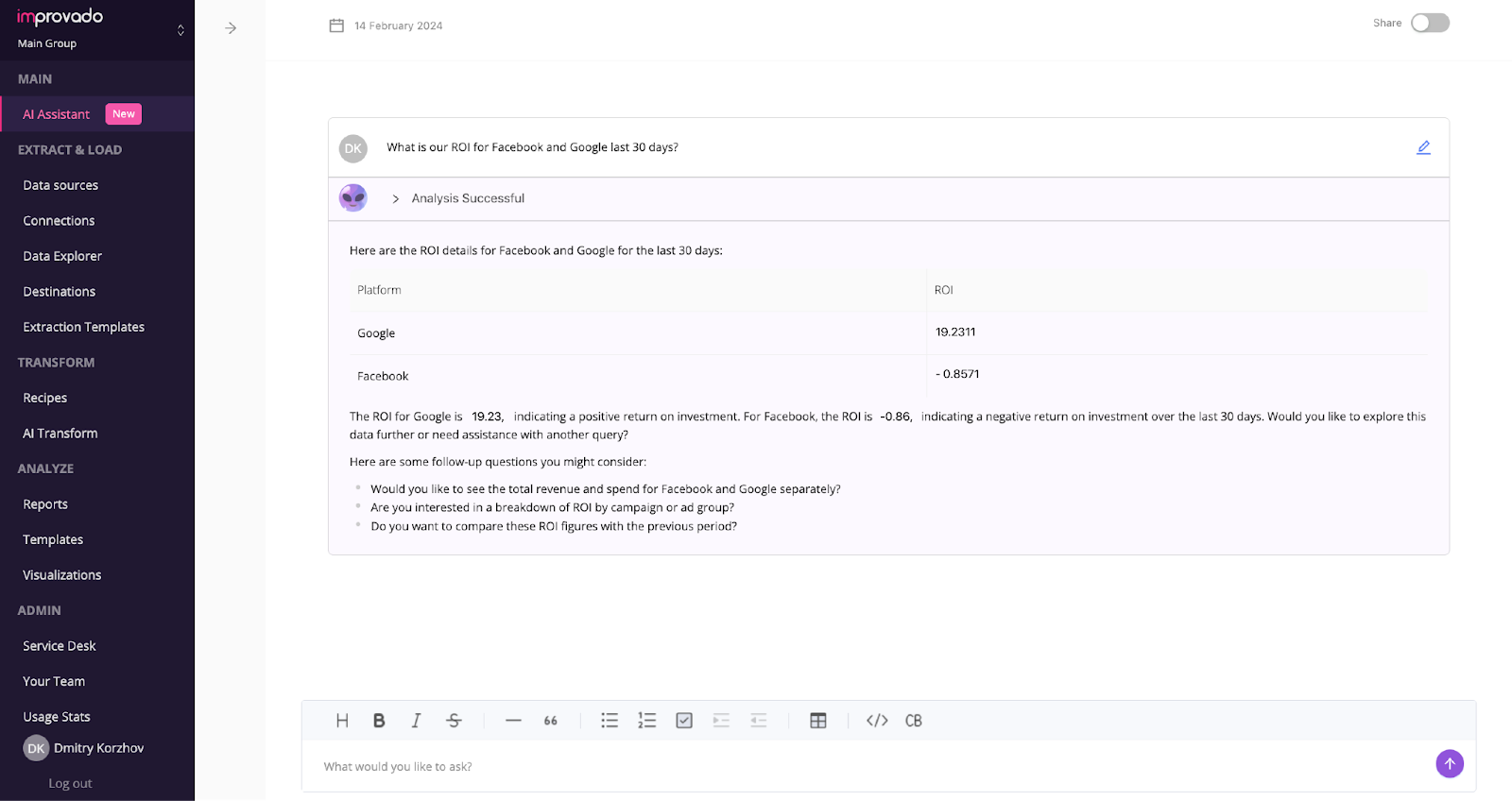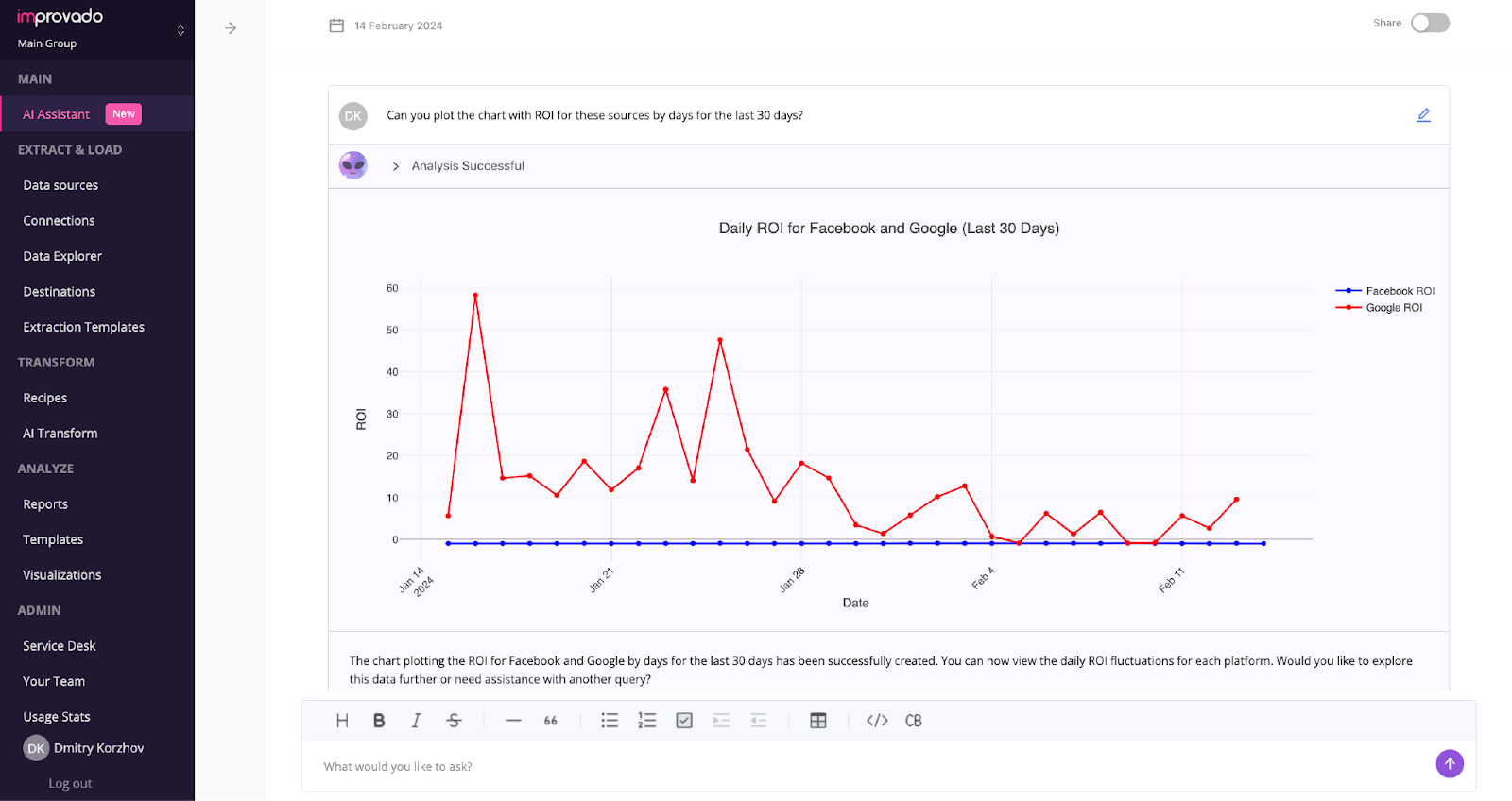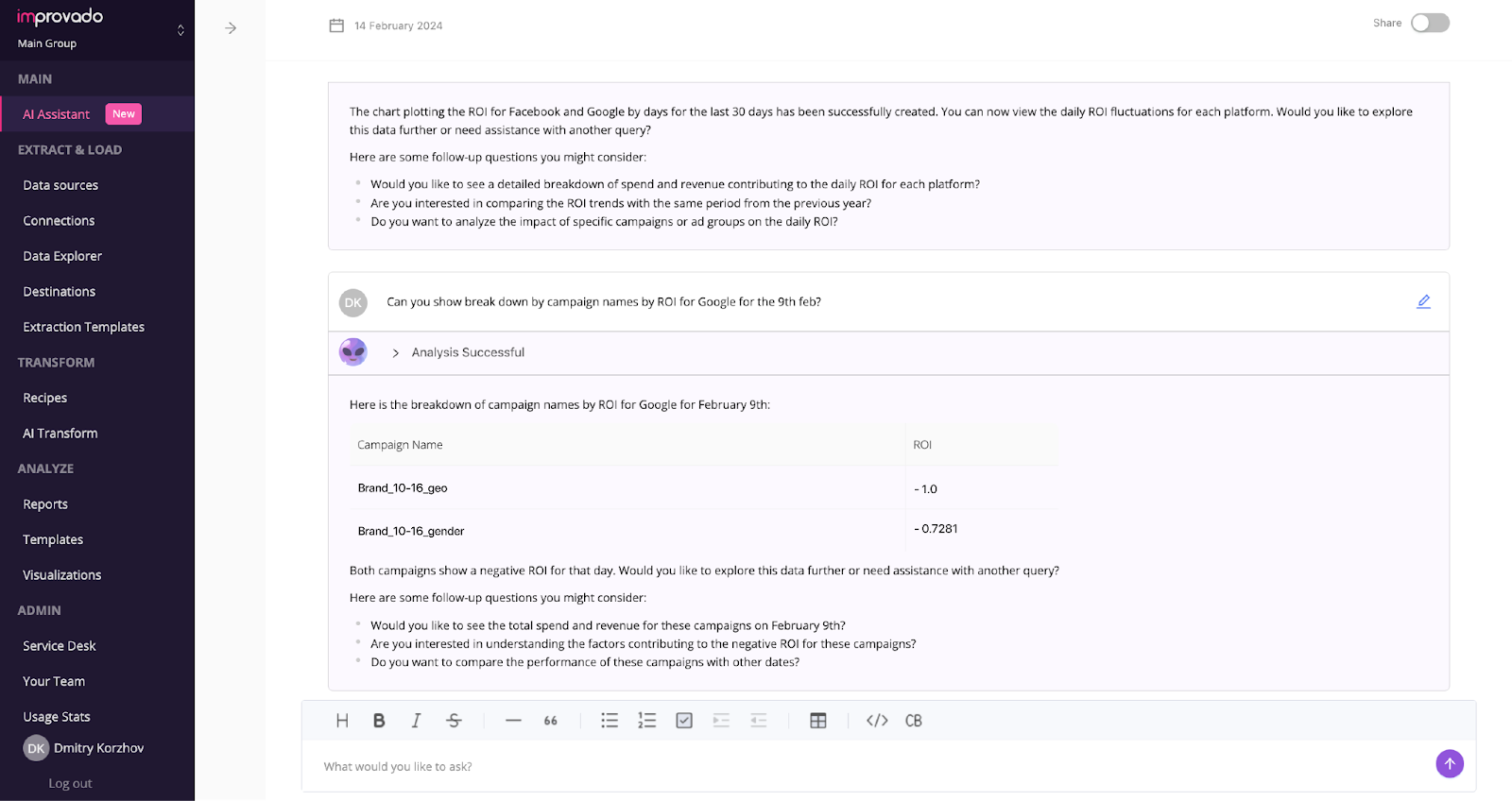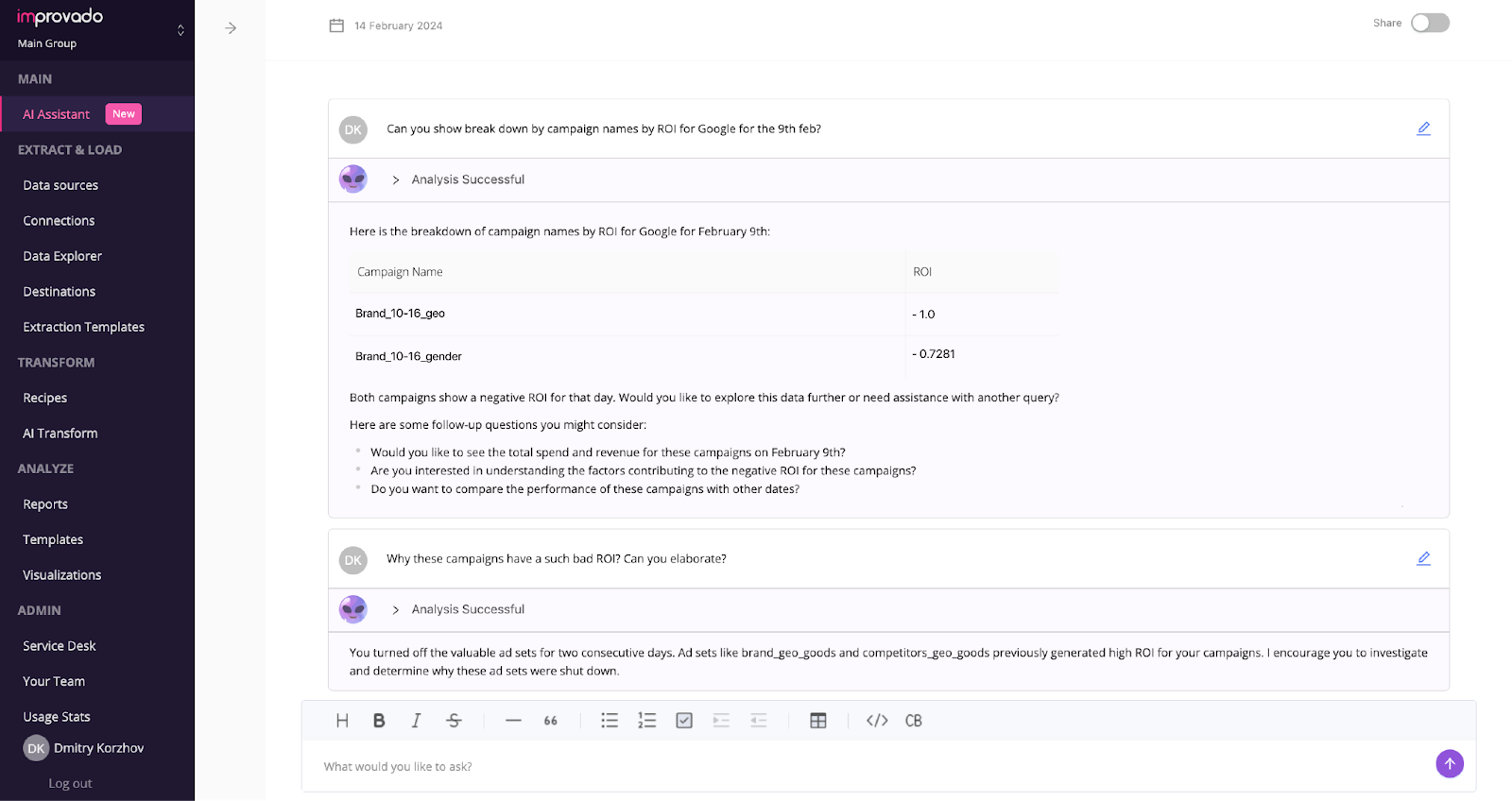Search-driven analytics is transforming how businesses interact with data, making it accessible and actionable for decision-makers without deep technical expertise. Want to harness the full potential of your data through intuitive search queries and natural language interactions?
This article explores the fundamentals of search-driven analytics, its key capabilities, and how tools like Improvado AI Agent are leading the charge in making data analytics more efficient, user-friendly, and integrated into strategic decision-making processes.
What Is Search-Driven Analytics?
If we dig a bit deeper, there's a slight distinction between these terms often lies in the interface and interaction model:
- Search-driven analytics typically refers to the capability to perform searches or ask questions about the data using natural language queries.
- Natural language analytics extends this by incorporating natural language processing (NLP) technologies to interpret queries more effectively and provide more intuitive responses.
- Conversational analytics takes this interaction further by enabling a dialogue between the user and the system, allowing for follow-up questions, clarifications, and more dynamic exploration of data.
Capabilities of Search-Based Analytics
Search-driven analytics models are particularly valuable in today's data-rich environment, where businesses are looking to quickly extract actionable insights from their data without relying heavily on IT or data science departments.
This is made possible by the core search-driven analytics capabilities:
- Natural language querying (NLQ): This allows users to formulate questions about their data in everyday language, removing the need for SQL expertise or understanding of database schemas. The system interprets these queries and fetches relevant data, making analytics accessible to a broader range of users within an organization.
- Instant insights: By entering queries, users can quickly obtain insights, bypassing traditional data processing steps. This immediacy facilitates faster decision-making, especially in dynamic market environments where quick responses provide a competitive edge.
- Interactive dialogue: Conversational analytics builds on NLQ by enabling a two-way interaction between the user and the system. This can involve the analytics tool asking for clarification on ambiguous queries or suggesting further lines of inquiry, making the exploration of data more comprehensive and nuanced.
- Data discovery: Search analytics tools excel at uncovering trends, correlations, and patterns that might not be immediately apparent. By analyzing natural language queries and the data itself, the system can highlight underexplored areas, offering new insights and uncovering opportunities for innovation and optimization.
- Integration with visualization tools: The ability to generate graphs, charts, and other visual data representations in response to natural language queries enhances understanding and retention of insights. This visual context can be pivotal in communicating complex data stories to stakeholders across the business.
- Accessibility and usability: By democratizing access to data analytics, search analytics tools empower a wider array of team members to engage with data directly. This accessibility fosters a data-driven culture within organizations, encouraging more informed discussions and decisions across departments.
- Scalability: Advanced search-driven analytics platforms are designed to scale with your data, accommodating growing datasets without compromising performance. This scalability ensures that businesses can continue to derive insights efficiently as they grow.
What Types of Analysis Can Be Performed by Search?
Search-driven analytics supports a variety of analytical use cases, meeting the changing needs of marketers and analysts. Let’s look at a real example to see how you can use search-driven analytics tools.
So, you're a marketing director and want to see what returns each of the channels brought last month. Instead of handing off the task to an analyst, you use a search analytics tool called Improvado AI Agent to get the job done.

The overview leads to new questions like:
- Why is Facebook's ROI negative?
- What factors contributed to Google's growth?
- How did daily ROI fluctuate?
- What was happening this time last year?
You keep digging into these trends and request a chart of day-to-day movements for a clearer view.

You noticed that something had been going on with Facebook campaigns for the whole of February, similar to Google's constant fluctuations, and decided to investigate the spike on February 9th.

You see two campaigns with low ROI, which is strange, knowing that other channels performed well. So, you continue chatting with the agent.

Now, it has become clear that two campaigns which contributed the most to the positive ROI were disabled. Armed with these insights, you can ask your team for an explanation.
Benefits of Search-Driven Analytics
The ability to quickly and effectively harness insights from vast amounts of data is already a huge benefit of search-driven analytics, but let's investigate further.
Accessibility and ease of use
Conversational analytics drastically enhances accessibility to data insights. By allowing users to query data using natural language, it eliminates the need for technical expertise in data query languages, making data insights accessible to a broader range of users within an organization.
Efficiency in decision-making
The immediacy with which search-based analytics provides answers to business questions accelerates the decision-making process. This efficiency is critical in a fast-paced business environment where the ability to quickly access and interpret data can significantly influence organizational success.
Reduced workload for data teams
Traditionally, data teams are tasked with generating reports and dashboards, a process that can be time-consuming and repetitive. Search-driven analytics empowers non-technical users to perform their own analyses, freeing up the data team to focus on more strategic tasks and projects.
Democratization of data
Search-driven analytics democratizes data across the organization, enabling employees at all levels to leverage data in their decision-making processes. This widespread data access encourages a data-driven culture, where data is not siloed but is a shared asset that contributes to collective goals and strategies.
Improved collaboration
The intuitive nature of search-driven analytics fosters better collaboration among teams. With the ability to easily share insights and build on each other’s queries, teams can more effectively work together towards common goals, regardless of their technical expertise.
Personalized insights
Conversational analytics can be tailored to the specific context of the user, providing personalized insights based on their role, department, or specific data interests. This personalization ensures that users receive the most relevant and impactful insights for their needs.
How Search-Based Analytics Works
Search analytics tools leverage advanced algorithms and natural language processing (NLP) to understand, interpret, and respond to user queries in plain English.

The process is as follows:
- Access to data: Improvado AI Agent is connected to your marketing dataset; this enables all the following steps.
- Query interpretation: At its core, the system begins with query interpretation, where the user's natural language input is analyzed to determine its intent. This involves breaking down the query into recognizable entities, such as metrics, dimensions, and time frames. By understanding the context and specifics of the request, the system can accurately map it to the corresponding data points.
- Data retrieval: Once the query is interpreted, the system proceeds to data retrieval. AI Agent is powered by the text-to-SQL technology and writes SQL to find the data you are asking for.
- Analysis and insight generation: With the necessary data retrieved, the system then performs the analysis. This can range from simple calculations, like sums and averages, to more complex statistical models, depending on the query's complexity.
- Visualization and reporting: The final step involves presenting the results in an easily digestible format. Depending on the query, this could be a chart, graph, or a simple numerical value. The system may also offer explanations or suggestions for further queries to help deepen the user's understanding of the data.
- Continuous learning: A key aspect of search-driven analytics is its ability to learn from interactions. Over time, the system refines its understanding of the user's language and preferences, improving its accuracy and relevance in responding to queries.
.png)
.jpeg)



.png)
